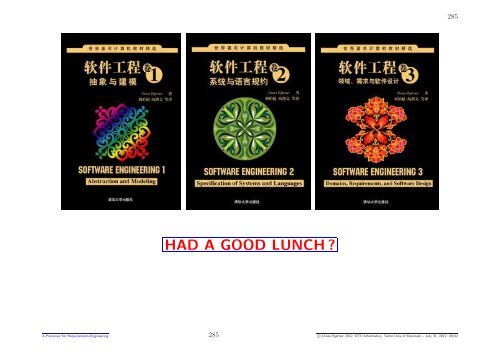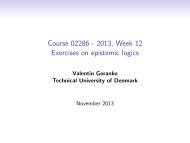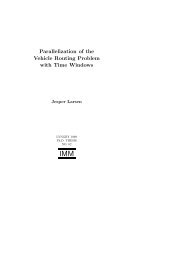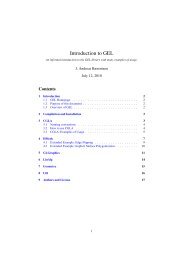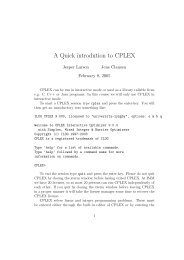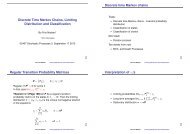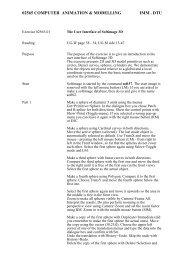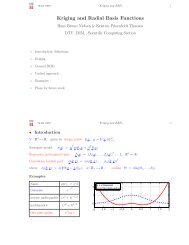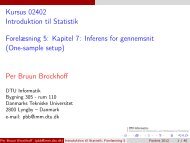L6: Analysers: Parts ad Materials - DTU Informatics
L6: Analysers: Parts ad Materials - DTU Informatics
L6: Analysers: Parts ad Materials - DTU Informatics
You also want an ePaper? Increase the reach of your titles
YUMPU automatically turns print PDFs into web optimized ePapers that Google loves.
285<br />
HAD A GOOD LUNCH ?<br />
A Precursor for Requirements Engineering 285 c○ Dines Bjørner 2012, <strong>DTU</strong> <strong>Informatics</strong>, Techn.Univ.of Denmark – July 31, 2012: 09:02
286<br />
Begin of Lecture 6: First Session — Calculus I<br />
Part and Material Discoverers<br />
FM 2012 Tutorial, Dines Bjørner, Paris, 28 August 2012<br />
c○ Dines Bjørner 2012, <strong>DTU</strong> <strong>Informatics</strong>, Techn.Univ.of Denmark – July 31, 2012: 09:02 286 Domain Science & Engineering
286<br />
Tutorial Schedule<br />
• Lectures 1–2 9:00–9:40 + 9:50–10:30<br />
1 Introduction Slides 1–35<br />
2 Endurant Entities: <strong>Parts</strong> Slides 36–110<br />
• Lectures 3–5 11:00–11:15 + 11:20–11:45 + 11:50–12:30<br />
3 Endurant Entities: <strong>Materials</strong>, States Slides 111–142<br />
4 Perdurant Entities: Actions and Events Slides 143–174<br />
5 Perdurant Entities: Behaviours Slides 175–285<br />
Lunch 12:30–14:00<br />
• Lectures 6–7 14:00–14:40 + 14:50–15:30<br />
√ 6 A Calculus: <strong>Analysers</strong>, <strong>Parts</strong> and <strong>Materials</strong> Slides 286–339<br />
7 A Calculus: Function Signatures and Laws Slides 340–377<br />
• Lectures 8–9 16:00–16:40 + 16:50–17:30<br />
8 Domain and Interface Requirements Slides 378–424<br />
9 Conclusion: Comparison to Other Work Slides 428–460<br />
Conclusion: What Have We Achieved Slides 425–427 + 461–472<br />
c○ Dines Bjørner 2012, <strong>DTU</strong> <strong>Informatics</strong>, Techn.Univ.of Denmark – July 31, 2012: 09:02 286 Domain Science & Engineering
11.<br />
287<br />
11. Towards a Calculus of Domain Discoverers<br />
• The ‘towards’ term is significant.<br />
• We are not presenting<br />
⋄ a “re<strong>ad</strong>y to serve”<br />
⋄ comprehensive,<br />
⋄ tested and tried<br />
calculus.<br />
• We hope that the one we show you is interesting.<br />
• It is, we think, the first time such a calculus is presented.<br />
A Precursor for Requirements Engineering 287 c○ Dines Bjørner 2012, <strong>DTU</strong> <strong>Informatics</strong>, Techn.Univ.of Denmark – July 31, 2012: 09:02
288<br />
11. Towards a Calculus of Domain Discoverers<br />
• By a domain description calculus<br />
⋄ or, as we shall also call it,<br />
◦ either a domain discovery calculus<br />
◦ or a calculus of domain discoverers<br />
we shall understand an algebra, that is,<br />
⋄ a set of meta-operations and<br />
⋄ a pair of<br />
◦ a fixed domain and<br />
◦ a varying repository.<br />
• The meta-operations will be outlined in this section.<br />
• The fixed domain is of the kind of domains alluded to in the previous section of<br />
this tutorial.<br />
• The varying repository contains fragments of a description of the fixed domain.<br />
c○ Dines Bjørner 2012, <strong>DTU</strong> <strong>Informatics</strong>, Techn.Univ.of Denmark – July 31, 2012: 09:02 288 Domain Science & Engineering
11. Towards a Calculus of Domain Discoverers<br />
289<br />
• The meta-operators are referred to as<br />
⋄ either domain analysis meta-functions<br />
⋄ or domain discovery meta-functions.<br />
• The former are carried out by the domain analyser when inquiring (the domain)<br />
as to its properties.<br />
• The latter are carried out by the domain describer when deciding upon which<br />
descriptions “to go for” !<br />
• The two persons can be the same one domain engineer.<br />
• The operators are referred to as meta-functions,<br />
⋄ or meta-linguistic functions,<br />
⋄ since they are<br />
◦ applied and<br />
⋄ by humans, i.e., the domain describers.<br />
◦ calculated<br />
• They are directives which can be referred to by the domain describers while<br />
carrying out their analytic and creative work.<br />
A Precursor for Requirements Engineering 289 c○ Dines Bjørner 2012, <strong>DTU</strong> <strong>Informatics</strong>, Techn.Univ.of Denmark – July 31, 2012: 09:02
290 11. Towards a Calculus of Domain Discoverers 11.1. Introductory Notions<br />
11.1. Introductory Notions<br />
• In order to present the operators of the calculus<br />
⋄ we must clear a few concepts.<br />
11.1.1. Discovery<br />
• By a domain discovery calculus we shall understand<br />
⋄ a set of operations (the domain discoverers),<br />
◦ which when applied to a domain<br />
◦ by a human agent, the domain describer,<br />
and<br />
◦ yield domain description texts.<br />
c○ Dines Bjørner 2012, <strong>DTU</strong> <strong>Informatics</strong>, Techn.Univ.of Denmark – July 31, 2012: 09:02 290 Domain Science & Engineering
11. Towards a Calculus of Domain Discoverers 11.1. Introductory Notions11.1.1. Discovery<br />
291<br />
• The domain discoverers are applied “mentally”.<br />
⋄ That is, not in a mechanisable way.<br />
◦ It is not like when procedure calls<br />
◦ invoke computations<br />
◦ of a computer.<br />
⋄ But they are applied by the domain describer.<br />
⋄ That person is to follow the ideas laid down for<br />
⋄ these domain discoverers<br />
◦ (as they were in the earlier parts of this talk).<br />
⋄ They serve to guide the domain engineer<br />
◦ to discoverer the desired domain entities<br />
◦ and their properties.<br />
• In this section we shall review an ensemble of (so far) nine domain<br />
discoverers and (so far) four domain analysers.<br />
A Precursor for Requirements Engineering 291 c○ Dines Bjørner 2012, <strong>DTU</strong> <strong>Informatics</strong>, Techn.Univ.of Denmark – July 31, 2012: 09:02
292 11. Towards a Calculus of Domain Discoverers 11.1. Introductory Notions11.1.1. Discovery<br />
We list the nine domain discoverers.<br />
• [ Slide 320] PART SORTS,<br />
[ Slide 317] MATEREIAL SORTS,<br />
[ Slide 324] PART TYPES,<br />
[ Slide 327] UNIQUE ID,<br />
[ Slide 328] MEREOLOGY,<br />
[ Slide 332] ATTRIBUTES,<br />
[ Slide 341] ACTION SIGNATURES,<br />
[ Slide 346] EVENT SIGNATURES and<br />
[ Slide 349] BEHAVIOUR SIGNATURES.<br />
c○ Dines Bjørner 2012, <strong>DTU</strong> <strong>Informatics</strong>, Techn.Univ.of Denmark – July 31, 2012: 09:02 292 Domain Science & Engineering
11. Towards a Calculus of Domain Discoverers 11.1. Introductory Notions11.1.2. Analysis<br />
293<br />
11.1.2. Analysis<br />
• In order to “apply” these domain discoverers certain conditions<br />
must be satisfied.<br />
• Some of these condition inquiries can be represented by (so far)<br />
four domain analysers.<br />
⋄ [ Slide 306] IS MATERIALS BASED ,<br />
[ Slide 308] IS ATOM,<br />
[ Slide 308] IS COMPOSITE and<br />
[ Slide 312] HAS A CONCRETE TYPE.<br />
A Precursor for Requirements Engineering 293 c○ Dines Bjørner 2012, <strong>DTU</strong> <strong>Informatics</strong>, Techn.Univ.of Denmark – July 31, 2012: 09:02
294 11. Towards a Calculus of Domain Discoverers 11.1. Introductory Notions11.1.3. Domain Indexes<br />
11.1.3. Domain Indexes<br />
• In order to discover, the domain describer must decide on<br />
“where & what in the domain” to analyse and describe.<br />
• One can, for this purpose, think of the domain as<br />
semi-lattice-structured.<br />
⋄ The root of the lattice is then labelled ∆.<br />
⋄ Let us refer to the domain as ∆.<br />
⋄ We say that it has index 〈∆〉.<br />
⋄ Initially we analyse the usually composite ∆ domain to consist of<br />
one or more distinctly typed parts p 1 :t 1 , p 2 :t 2 , . . . , p m :t m .<br />
⋄ Each of these have indexes 〈∆,t i 〉.<br />
⋄ So we view ∆, in the semi-lattice, to be the join of m<br />
sub-semi-lattices whose roots we shall label with t 1 , t 2 , . . . , t m .<br />
c○ Dines Bjørner 2012, <strong>DTU</strong> <strong>Informatics</strong>, Techn.Univ.of Denmark – July 31, 2012: 09:02 294 Domain Science & Engineering
11. Towards a Calculus of Domain Discoverers 11.1. Introductory Notions11.1.3. Domain Indexes<br />
295<br />
⋄ And so forth for any composite part type t i , etcetera.<br />
⋄ It may be that any two or more such sub-semi-lattice root types,<br />
t ij , t ij , ..., t ik designate the same, shared type t ix , that is t ij =<br />
t ij = ... = t ik = t ix .<br />
⋄ If so then the k sub-semi-lattices are “collapsed” into one<br />
sub-semi-lattice.<br />
⋄ The building of the semi-lattice terminates when one can no<br />
longer analyse part types into further sub-semi-lattices, that is,<br />
when these part types are atomic.<br />
A Precursor for Requirements Engineering 295 c○ Dines Bjørner 2012, <strong>DTU</strong> <strong>Informatics</strong>, Techn.Univ.of Denmark – July 31, 2012: 09:02
296<br />
11. Towards a Calculus of Domain Discoverers 11.1. Introductory Notions11.1.3. Domain Indexes<br />
∆<br />
Line Domain<br />
VS<br />
Container Vessels<br />
Vs<br />
TS<br />
Container Terminal Ports<br />
Ts<br />
Vehicle Monitoring<br />
Net N Fleet<br />
∆<br />
F<br />
Domain<br />
M<br />
Monitor<br />
Container Vessel<br />
V T Container Terminal Port<br />
BS<br />
Bays<br />
Bs<br />
B Bay<br />
HS LS<br />
Hubs Links<br />
Hs Ls<br />
VS<br />
Vehicles<br />
Vs<br />
RS<br />
Rs<br />
R<br />
Rows<br />
Row<br />
H L V Vehicle<br />
Hub Link<br />
< ∆>,<br />
< ∆,N>, < ∆,F>, < ∆,M><br />
< ∆,N,HS>, < ∆,N,LS>, < ∆,F,VS><br />
< ∆,N,HS,Hs>, < ∆,N,LS,Ls>, < ∆,F,VS,Vs>,<br />
< ∆,N,HS,Hs,H>, < ∆,N,LS,Ls,L>, < ,F,VS,Vs,V><br />
∆<br />
Container Body<br />
SS<br />
Stacks<br />
Ss<br />
S Stack<br />
C Container<br />
K FS<br />
Freights<br />
Fs<br />
F Freight<br />
Figure 3: Domain indices<br />
c○ Dines Bjørner 2012, <strong>DTU</strong> <strong>Informatics</strong>, Techn.Univ.of Denmark – July 31, 2012: 09:02 296 Domain Science & Engineering
11. Towards a Calculus of Domain Discoverers 11.1. Introductory Notions11.1.3. Domain Indexes<br />
• That is, the roots of the sub-trees of the ∆ tree are labelled with<br />
type names.<br />
⋄ Every point in the semi-lattice can be identified by a domain<br />
index.<br />
◦ The root is defined to have index 〈∆〉.<br />
◦ The immediate sub-semi-lattices of ∆ have domain indexes<br />
〈∆,t 1 〉, 〈∆,t 2 〉, . . . , 〈∆,t m 〉.<br />
◦ And so forth.<br />
◦ If l̂〈t〉 is a prefix of another domain index, say l̂〈t,t ′ 〉,<br />
then t designates a composite type.<br />
297<br />
A Precursor for Requirements Engineering 297 c○ Dines Bjørner 2012, <strong>DTU</strong> <strong>Informatics</strong>, Techn.Univ.of Denmark – July 31, 2012: 09:02
298<br />
11. Towards a Calculus of Domain Discoverers 11.1. Introductory Notions11.1.3. Domain Indexes<br />
• For every domain index, l̂〈t〉,<br />
that index designates the type t domain type texts.<br />
• These texts consists of several sub-texts.<br />
• There are the texts directly related to the parts, p:P:<br />
⋄ the observer functions, obs · · · , if type t is composite,<br />
⋄ the unique identifier functions, uid P,<br />
⋄ the mereology function, mereo P, and<br />
⋄ the attribute functions, attr · · · .<br />
⋄ To the above “<strong>ad</strong>d”<br />
◦ possible auxiliary types and auxiliary functions<br />
◦ as well as possible axioms.<br />
c○ Dines Bjørner 2012, <strong>DTU</strong> <strong>Informatics</strong>, Techn.Univ.of Denmark – July 31, 2012: 09:02 298 Domain Science & Engineering
11. Towards a Calculus of Domain Discoverers 11.1. Introductory Notions11.1.3. Domain Indexes<br />
299<br />
• Then there are the texts related to<br />
⋄ actions,<br />
⋄ events, and<br />
⋄ behaviours<br />
“based” (primarily) on parts p:P.<br />
• These texts consists of<br />
⋄ function signatures (for actions, events, and behaviours),<br />
⋄ function definitions for these, and<br />
⋄ channel<br />
◦ declarations and<br />
◦ channel message type definitions<br />
for behaviours.<br />
We shall soon see examples of the above.<br />
A Precursor for Requirements Engineering 299 c○ Dines Bjørner 2012, <strong>DTU</strong> <strong>Informatics</strong>, Techn.Univ.of Denmark – July 31, 2012: 09:02
300<br />
11. Towards a Calculus of Domain Discoverers 11.1. Introductory Notions11.1.3. Domain Indexes<br />
• But not all can be “discovered” by just examining the domain from<br />
the point of view of a sub-semi-lattice type.<br />
⋄ Many interesting action, event and behaviour signatures depend<br />
on domain type texts designated by “roots” of disjoint sub-trees<br />
of the semi-lattice.<br />
⋄ Each such root has its own domain index.<br />
⋄ Together a meet of the semi-lattice is defined by the set of<br />
disjoint domain indices: {l i ,l j , · · · ,l k }.<br />
• It is thus that we arrive at a proper semi-lattice structure relating<br />
the various entities of the domain rooted in ∆.<br />
c○ Dines Bjørner 2012, <strong>DTU</strong> <strong>Informatics</strong>, Techn.Univ.of Denmark – July 31, 2012: 09:02 300 Domain Science & Engineering
11. Towards a Calculus of Domain Discoverers 11.1. Introductory Notions11.1.3. Domain Indexes<br />
301<br />
• The domain discoverers are therefore provided with arguments:<br />
⋄ either a single domain index, DOMAIN FUNCTION(l),<br />
⋄ or a pair, DOMAIN FUNCTION(l)({l i ,l j , · · · ,l k }),<br />
◦ the single domain index l and<br />
◦ a set of domain indices, {l i ,l j , · · · ,l k }<br />
where DOMAIN FUNCTION is any of the<br />
◦ domain discoverers or<br />
◦ domain analysers<br />
listed earlier.<br />
A Precursor for Requirements Engineering 301 c○ Dines Bjørner 2012, <strong>DTU</strong> <strong>Informatics</strong>, Techn.Univ.of Denmark – July 31, 2012: 09:02
302<br />
11. Towards a Calculus of Domain Discoverers 11.1. Introductory Notions11.1.4. The Repository<br />
11.1.4. The Repository<br />
• We have yet to give the full signature of the domain discoverers and<br />
domain analysers.<br />
⋄ One argument of these meta-functions<br />
◦ was parts of the actual domain<br />
◦ as designated by the domain indices.<br />
⋄ Another argument<br />
◦ is to be the Repository of description texts<br />
◦ being inspected (together with the sub-domain) when<br />
∗ analysing that sub-domain and<br />
◦ being updated<br />
∗ when “generating” the “discovered” description texts.<br />
c○ Dines Bjørner 2012, <strong>DTU</strong> <strong>Informatics</strong>, Techn.Univ.of Denmark – July 31, 2012: 09:02 302 Domain Science & Engineering
11. Towards a Calculus of Domain Discoverers 11.1. Introductory Notions11.1.4. The Repository<br />
303<br />
⋄ We can assume, without loss of generality, that<br />
◦ the Repository of description texts<br />
◦ is the description texts discovered so far.<br />
⋄ The result of domain analysis is either undefined or a truth value.<br />
We can assume, without any loss of generality that that result is<br />
not recorded.<br />
⋄ The result of domain discovery is either undefined or is a<br />
description text consisting of two well-defined fragments:<br />
◦ a narrative text, and<br />
◦ a formal text.<br />
⋄ Those well-defined texts are “<strong>ad</strong>ded” to the text of the<br />
Repository of description texts.<br />
◦ For pragmatic reasons,<br />
◦ when we explain the positive effect of domain discovery,<br />
◦ then we show just this “<strong>ad</strong>dition” to the Repository.<br />
A Precursor for Requirements Engineering 303 c○ Dines Bjørner 2012, <strong>DTU</strong> <strong>Informatics</strong>, Techn.Univ.of Denmark – July 31, 2012: 09:02
304<br />
11. Towards a Calculus of Domain Discoverers 11.1. Introductory Notions11.1.4. The Repository<br />
102. The proper type of the discover functions is therefore:<br />
102. DISCOVER FUNCTION: Index→Index-set→R ∼ →R<br />
• In the following we shall omit the Repository argument and result.<br />
103. So, inste<strong>ad</strong> of showing the discovery function invocation and result<br />
as:<br />
103. DISCOVER FUNCTION(l)(lset)(ρ) = ρ ′<br />
• where ρ ′ incorporates a pair of texts and RSL formulas,<br />
104. we shall show the discover function signature, the invocation and<br />
the result as:<br />
104. DISCOVER FUNCTION: Index→Index-set ∼ →(Narr Text×RSL Text)<br />
104. DISCOVER FUNCTION(l)(lset): (narr text,RSL text)<br />
c○ Dines Bjørner 2012, <strong>DTU</strong> <strong>Informatics</strong>, Techn.Univ.of Denmark – July 31, 2012: 09:02 304 Domain Science & Engineering
11. Towards a Calculus of Domain Discoverers 11.2. Domain <strong>Analysers</strong><br />
305<br />
11.2. Domain <strong>Analysers</strong><br />
• Currently we identify four analysis functions.<br />
• As the discovery calculus evolves<br />
⋄ (through further practice and research)<br />
⋄ we expect further analysis functions to be identified.<br />
A Precursor for Requirements Engineering 305 c○ Dines Bjørner 2012, <strong>DTU</strong> <strong>Informatics</strong>, Techn.Univ.of Denmark – July 31, 2012: 09:02
306<br />
11. Towards a Calculus of Domain Discoverers 11.2. Domain <strong>Analysers</strong>11.2.1. IS MATERIALS BASED<br />
11.2.1. IS MATERIALS BASED<br />
• You are reminded of the Continuous Endurant Modelling frame<br />
on Slide 132.<br />
IS MATERIALS BASED<br />
• An early decision has to be m<strong>ad</strong>e as to whether a domain is significantly<br />
based on materials or not:<br />
105. IS MATERIALS BASED(〈∆ Name 〉).<br />
• If Item 105 holds of a domain ∆ Name<br />
⋄ then the domain describer can apply<br />
⋄ MATERIAL SORTS (Item 107 on page 317).<br />
c○ Dines Bjørner 2012, <strong>DTU</strong> <strong>Informatics</strong>, Techn.Univ.of Denmark – July 31, 2012: 09:02 306 Domain Science & Engineering
11. Towards a Calculus of Domain Discoverers 11.2. Domain <strong>Analysers</strong>11.2.1. IS MATERIALS BASED<br />
307<br />
Example: 45 Pipelines and Transports: <strong>Materials</strong> or <strong>Parts</strong>.<br />
• IS MATERIALS BASED(〈∆ Pipeline 〉) = true.<br />
• IS MATERIALS BASED(〈∆ Transport 〉)= false.<br />
A Precursor for Requirements Engineering 307 c○ Dines Bjørner 2012, <strong>DTU</strong> <strong>Informatics</strong>, Techn.Univ.of Denmark – July 31, 2012: 09:02
308 11. Towards a Calculus of Domain Discoverers 11.2. Domain <strong>Analysers</strong>11.2.2. IS ATOM, IS COMPOSITE<br />
11.2.2. IS ATOM, IS COMPOSITE<br />
• During the discovery process<br />
⋄ discrete part types arise (i.e., the names are yielded)<br />
⋄ and these may either denote atomic or composite parts.<br />
• The domain describer<br />
⋄ must now decide as to<br />
⋄ whether a named, discrete type is atomic or is composite.<br />
c○ Dines Bjørner 2012, <strong>DTU</strong> <strong>Informatics</strong>, Techn.Univ.of Denmark – July 31, 2012: 09:02 308 Domain Science & Engineering
11. Towards a Calculus of Domain Discoverers 11.2. Domain <strong>Analysers</strong>11.2.2. IS ATOM, IS COMPOSITE<br />
309<br />
IS ATOM<br />
• The IS ATOM analyser serves that purpose:<br />
value<br />
IS ATOM: Index ∼ → Bool<br />
IS ATOM(l̂〈t〉) ≡ true | false | chaos<br />
• The analysis is undefined for ill-formed indices.<br />
Example: 46 Transport Nets: Atomic <strong>Parts</strong> (II). We refer to<br />
Example 3 (Slide 16).<br />
IS ATOM(〈∆,N,HS,Hs,H〉),<br />
∼ IS ATOM(〈∆,N,HS,Hs〉),<br />
IS ATOM(〈∆,N,LS,Ls,L〉)<br />
∼ IS ATOM(〈∆,N,LS,Ls〉)<br />
A Precursor for Requirements Engineering 309 c○ Dines Bjørner 2012, <strong>DTU</strong> <strong>Informatics</strong>, Techn.Univ.of Denmark – July 31, 2012: 09:02
310 11. Towards a Calculus of Domain Discoverers 11.2. Domain <strong>Analysers</strong>11.2.2. IS ATOM, IS COMPOSITE<br />
IS COMPOSITE<br />
• The IS COMPOSITE analyser is<br />
⋄ similarly applied by the domain describer<br />
⋄ to a part type t<br />
⋄ to help decide whether t is a composite type.<br />
value<br />
IS COMPOSITE: Index ∼ → Bool<br />
IS COMPOSITE(l̂〈t〉) ≡ true | false | chaos<br />
c○ Dines Bjørner 2012, <strong>DTU</strong> <strong>Informatics</strong>, Techn.Univ.of Denmark – July 31, 2012: 09:02 310 Domain Science & Engineering
11. Towards a Calculus of Domain Discoverers 11.2. Domain <strong>Analysers</strong>11.2.2. IS ATOM, IS COMPOSITE<br />
311<br />
Example: 47 Transport Nets: Composite <strong>Parts</strong>. We refer to<br />
Example 3 (Slide 16)<br />
IS COMPOSITE(〈∆〉),<br />
IS COMPOSITE(〈∆,N〉)<br />
IS COMPOSITE(〈∆,N,HS,Hs〉),<br />
IS COMPOSITE(〈∆,N,LS,Ls〉)<br />
∼ IS COMPOSITE(〈∆,N,HS,Hs,H〉),<br />
∼ IS COMPOSITE(〈∆,N,LS,Ls,L〉)<br />
A Precursor for Requirements Engineering 311 c○ Dines Bjørner 2012, <strong>DTU</strong> <strong>Informatics</strong>, Techn.Univ.of Denmark – July 31, 2012: 09:02
312 11. Towards a Calculus of Domain Discoverers 11.2. Domain <strong>Analysers</strong>11.2.3. HAS A CONCRETE TYPE<br />
11.2.3. HAS A CONCRETE TYPE<br />
• Sometimes we find it expedient<br />
⋄ to endow a “discovered” sort with a concrete type expression,<br />
that is,<br />
⋄ “turn” a sort definition into a concrete type definition.<br />
HAS A CONCRETE TYPE<br />
106. Thus we introduce the analyser:<br />
106 HAS A CONCRETE TYPE: Index → ∼ Bool<br />
106 HAS A CONCRETE TYPE(l̂〈t〉): true | false | chaos<br />
c○ Dines Bjørner 2012, <strong>DTU</strong> <strong>Informatics</strong>, Techn.Univ.of Denmark – July 31, 2012: 09:02 312 Domain Science & Engineering
11. Towards a Calculus of Domain Discoverers 11.2. Domain <strong>Analysers</strong>11.2.3. HAS A CONCRETE TYPE<br />
313<br />
Example: 48 Transport Nets: Concrete Types . We refer to<br />
Example 3 (Slide 16) while exemplifying four cases:<br />
HAS A CONCRETE TYPE(〈∆,N,HS,Hs〉)<br />
HAS A CONCRETE TYPE(〈∆,N,LS,Ls〉)<br />
∼ HAS A CONCRETE TYPE(〈∆,N,HS,Hs,H〉)<br />
∼ HAS A CONCRETE TYPE(〈∆,N,LS,Ls,L〉)<br />
A Precursor for Requirements Engineering 313 c○ Dines Bjørner 2012, <strong>DTU</strong> <strong>Informatics</strong>, Techn.Univ.of Denmark – July 31, 2012: 09:02
314 11. Towards a Calculus of Domain Discoverers 11.2. Domain <strong>Analysers</strong>11.2.3. HAS A CONCRETE TYPE<br />
• We remind the listener that<br />
⋄ it is a decision m<strong>ad</strong>e by the domain describer<br />
⋄ as to whether a part type is<br />
◦ to be considered a sort or<br />
◦ be given a concrete type.<br />
• We shall later cover a domain discoverer related to the positive<br />
outcome of the above inquiry.<br />
c○ Dines Bjørner 2012, <strong>DTU</strong> <strong>Informatics</strong>, Techn.Univ.of Denmark – July 31, 2012: 09:02 314 Domain Science & Engineering
11. Towards a Calculus of Domain Discoverers 11.3. Domain Discoverers<br />
315<br />
11.3. Domain Discoverers<br />
• A domain discoverer is a mental tool.<br />
⋄ It takes a written form shown earlier.<br />
⋄ It is to be “applied” by a human, the domain describer.<br />
⋄ The domain describer applies the domain discoverer to a<br />
fragment of the domain, as it is: “out there” !<br />
A Precursor for Requirements Engineering 315 c○ Dines Bjørner 2012, <strong>DTU</strong> <strong>Informatics</strong>, Techn.Univ.of Denmark – July 31, 2012: 09:02
316<br />
11. Towards a Calculus of Domain Discoverers 11.3. Domain Discoverers<br />
• ‘Application’ means the following.<br />
⋄ The domain describer examines the domain as directed by the<br />
explanation given for the domain discoverer — as here, in these<br />
lectures.<br />
⋄ As the brain of the domain describer views, examines, analyses, a<br />
domain index-designated fragment of the domain,<br />
◦ ideas as to which domain concepts to capture arise<br />
◦ and these take the form of pairs of narrative and formal texts.<br />
c○ Dines Bjørner 2012, <strong>DTU</strong> <strong>Informatics</strong>, Techn.Univ.of Denmark – July 31, 2012: 09:02 316 Domain Science & Engineering
11. Towards a Calculus of Domain Discoverers 11.3. Domain Discoverers11.3.1. MATERIAL SORTS<br />
317<br />
11.3.1. MATERIAL SORTS<br />
MATERIAL SORTS – I/II<br />
107. The MATERIAL SORTS discovery function applies to a domain,<br />
usually designated by 〈∆ Name 〉<br />
where Name is a pragmatic hinting at the domain by name.<br />
108. The result of the domain discoverer applying this meta-function<br />
is some narrative text<br />
109. and the types of the discovered materials<br />
110. usually affixed a comment<br />
(a) which lists the “somehow related” part types<br />
(b) and their related materials observers.<br />
A Precursor for Requirements Engineering 317 c○ Dines Bjørner 2012, <strong>DTU</strong> <strong>Informatics</strong>, Techn.Univ.of Denmark – July 31, 2012: 09:02
318<br />
11. Towards a Calculus of Domain Discoverers 11.3. Domain Discoverers11.3.1. MATERIAL SORTS<br />
MATERIAL SORTS II/II<br />
107. MATERIAL SORTS: 〈∆〉 → (Text × RSL)<br />
107. MATERIAL SORTS(〈∆ Name 〉):<br />
108. [ narrative text ;<br />
109. type M a , M b , ..., M c materials<br />
110. comment: related part types: P i , P j , ..., P k<br />
110. obs M n : P m → M n , ... ]<br />
105. pre: IS MATERIALS BASED(〈∆ Name 〉)<br />
c○ Dines Bjørner 2012, <strong>DTU</strong> <strong>Informatics</strong>, Techn.Univ.of Denmark – July 31, 2012: 09:02 318 Domain Science & Engineering
11. Towards a Calculus of Domain Discoverers 11.3. Domain Discoverers11.3.1. MATERIAL SORTS<br />
319<br />
Example: 49 Pipelines: Material.<br />
• MATERIAL SORTS(〈∆ Oil Pipeline System 〉):<br />
[ The oil pipeline system is focused on oil ;<br />
type O material<br />
comment related part type: U, obs O: U → O ]<br />
A Precursor for Requirements Engineering 319 c○ Dines Bjørner 2012, <strong>DTU</strong> <strong>Informatics</strong>, Techn.Univ.of Denmark – July 31, 2012: 09:02
320 11. Towards a Calculus of Domain Discoverers 11.3. Domain Discoverers11.3.2. PART SORTS<br />
11.3.2. PART SORTS<br />
PART SORTS I/II<br />
111. The part type discoverer PART SORTS<br />
(a) applies to a simply indexed domain, l̂〈t〉,<br />
(b) where t denotes a composite type, and yields a pair<br />
i. of narrative text and<br />
ii. formal text which itself consists of a pair:<br />
A. a set of type names<br />
B. each paired with a part (sort) observer.<br />
c○ Dines Bjørner 2012, <strong>DTU</strong> <strong>Informatics</strong>, Techn.Univ.of Denmark – July 31, 2012: 09:02 320 Domain Science & Engineering
11. Towards a Calculus of Domain Discoverers 11.3. Domain Discoverers11.3.2. PART SORTS<br />
321<br />
PART SORTS II/II<br />
value<br />
111. PART SORTS: Index → ∼ (Text×RSL)<br />
111(a). PART SORTS(l̂〈t〉):<br />
111((b))i. [ narrative, possibly enumerated texts ;<br />
111((b))iiA. type t 1 ,t 2 ,...,t m ,<br />
111((b))iiB. value obs t 1 :t→t 1 ,obs t 2 :t→t 2 ,...,obs t m :t→t m<br />
111(b). pre: IS COMPOSITE(l̂〈t〉) ]<br />
A Precursor for Requirements Engineering 321 c○ Dines Bjørner 2012, <strong>DTU</strong> <strong>Informatics</strong>, Techn.Univ.of Denmark – July 31, 2012: 09:02
322<br />
11. Towards a Calculus of Domain Discoverers 11.3. Domain Discoverers11.3.2. PART SORTS<br />
Example: 50 Transport: Part Sorts. We apply a concrete<br />
version of the above sort discoverer to the vehicle monitoring domain<br />
∆. See Example 36 (Slide 188).<br />
• PART SORTS(〈∆〉):<br />
[ the vehicle monitoring domain contains three sub-parts:<br />
net, fleet and monitor ;<br />
type N, F, M,<br />
value obs N: ∆ → N, obs F: ∆ → F, obs M: ∆ → M ]<br />
• PART SORTS(〈∆,N〉):<br />
[ the net domain contains two sub-parts:<br />
sets of hubs and sets of link ;<br />
type HS, LS,<br />
value obs HS: N → HS, obs LS: N → LS ]<br />
c○ Dines Bjørner 2012, <strong>DTU</strong> <strong>Informatics</strong>, Techn.Univ.of Denmark – July 31, 2012: 09:02 322 Domain Science & Engineering
11. Towards a Calculus of Domain Discoverers 11.3. Domain Discoverers11.3.2. PART SORTS<br />
323<br />
• PART SORTS(〈∆,F〉):<br />
[ the fleet domain consists of one sub-domain:<br />
set of vehicles;<br />
type VS,<br />
value obs VS: F → VS ]<br />
A Precursor for Requirements Engineering 323 c○ Dines Bjørner 2012, <strong>DTU</strong> <strong>Informatics</strong>, Techn.Univ.of Denmark – July 31, 2012: 09:02
324 11. Towards a Calculus of Domain Discoverers 11.3. Domain Discoverers11.3.3. PART TYPES<br />
11.3.3. PART TYPES<br />
PART TYPES I/II<br />
112. The PART TYPES discoverer applies to a composite sort, t,<br />
and yields a pair<br />
(a) of narrative, possibly enumerated texts [omitted], and<br />
(b) some formal text:<br />
i. a type definition, t c = te,<br />
ii. together with the sort definitions<br />
of so far undefined type names of te.<br />
iii. An observer function observes t c from t.<br />
iv. The PART TYPES discoverer is not defined<br />
if the designated sort is judged<br />
to not warrant a concrete type definition.<br />
c○ Dines Bjørner 2012, <strong>DTU</strong> <strong>Informatics</strong>, Techn.Univ.of Denmark – July 31, 2012: 09:02 324 Domain Science & Engineering
11. Towards a Calculus of Domain Discoverers 11.3. Domain Discoverers11.3.3. PART TYPES<br />
325<br />
PART TYPES II/II<br />
112. PART TYPES: Index → ∼ (Text×RSL)<br />
112. PART TYPES(l̂〈t〉):<br />
112(a). [ narrative, possibly enumerated texts ;<br />
112((b))i. type t c = te,<br />
112((b))ii. t α , t β , ..., t γ ,<br />
112((b))iii. value obs t c : t → t c<br />
112((b))iv. pre: HAS CONCRETE TYPE(l̂〈t〉) ]<br />
112((b))ii. where: type expression te contains<br />
112((b))ii. type names t α , t β , ..., t γ<br />
A Precursor for Requirements Engineering 325 c○ Dines Bjørner 2012, <strong>DTU</strong> <strong>Informatics</strong>, Techn.Univ.of Denmark – July 31, 2012: 09:02
326<br />
11. Towards a Calculus of Domain Discoverers 11.3. Domain Discoverers11.3.3. PART TYPES<br />
Example: 51 Transport: Concrete Part Types. Continuing<br />
Examples 36–50 and Example 3 – we omit narrative informal texts.<br />
PART TYPES(〈∆,F,VS〉):<br />
type V, Vs=V-set, value obs Vs: VS→Vs<br />
PART TYPES(〈∆,N,HS〉):<br />
type H, Hs=H-set, value obs Hs: HS→Hs<br />
PART TYPES(〈∆,N,LS〉):<br />
type L, Ls=L-set, value obs Ls: LS→Ls<br />
c○ Dines Bjørner 2012, <strong>DTU</strong> <strong>Informatics</strong>, Techn.Univ.of Denmark – July 31, 2012: 09:02 326 Domain Science & Engineering
11. Towards a Calculus of Domain Discoverers 11.3. Domain Discoverers11.3.4. UNIQUE ID<br />
327<br />
11.3.4. UNIQUE ID<br />
UNIQUE ID<br />
113. For every part type t we postulate a unique identity analyser function uid t.<br />
value<br />
113. UNIQUE ID: Index → (Text×RSL)<br />
113. UNIQUE ID(l̂〈t〉):<br />
113. [ narrative, possibly enumerated text ;<br />
113. type ti<br />
113. value uid t: t → ti ]<br />
Example: 52 Transport Nets: Unique Identifiers. Continuing Example 3:<br />
UNIQUE ID(〈∆,HS,Hs,H〉): type H, HI, value uid H→HI<br />
UNIQUE ID(〈∆,LS,Ls,L〉): type L, LI, value uid L→LI<br />
A Precursor for Requirements Engineering 327 c○ Dines Bjørner 2012, <strong>DTU</strong> <strong>Informatics</strong>, Techn.Univ.of Denmark – July 31, 2012: 09:02
328 11. Towards a Calculus of Domain Discoverers 11.3. Domain Discoverers11.3.5. MEREOLOGY<br />
11.3.5. MEREOLOGY<br />
• Given a part, p, of type t, the mereology, MEREOLOGY, of that<br />
part<br />
⋄ is the set of all the unique identifiers<br />
of the other parts to which part p is part-ship-related<br />
⋄ as “revealed” by the mereo ti i functions applied to p.<br />
• Henceforth we omit the otherwise necessary narrative texts.<br />
c○ Dines Bjørner 2012, <strong>DTU</strong> <strong>Informatics</strong>, Techn.Univ.of Denmark – July 31, 2012: 09:02 328 Domain Science & Engineering
11. Towards a Calculus of Domain Discoverers 11.3. Domain Discoverers11.3.5. MEREOLOGY<br />
329<br />
MEREOLOGY I/II<br />
114. Let type names t 1 , t 2 , ..., t n<br />
denote the types of all parts of a domain.<br />
115. Let type names ti 1 , ti 2 , ..., ti n 26 , be the corresponding<br />
type names of the unique identifiers of all parts of that domain.<br />
116. The mereology analyser MEREOLOGY is a generic function<br />
which applies to a pair of an index and an index set<br />
and yields some structure of unique identifiers.<br />
We suggest two possibilities,<br />
but otherwise leave it to the domain analyser<br />
to formulate the mereology function.<br />
117. Together with the “discovery” of the mereology function<br />
there usually follows some axioms.<br />
A Precursor for Requirements Engineering 329 c○ Dines Bjørner 2012, <strong>DTU</strong> <strong>Informatics</strong>, Techn.Univ.of Denmark – July 31, 2012: 09:02
330<br />
11. Towards a Calculus of Domain Discoverers 11.3. Domain Discoverers11.3.5. MEREOLOGY<br />
MEREOLOGY II/II<br />
type<br />
114. t 1 , t 2 , ..., t n<br />
115. t idx = ti 1 | ti 2 | ... | ti n<br />
116. MEREOLOGY: Index → ∼ Index-set → ∼ (Text×RSL)<br />
116. MEREOLOGY(l̂〈t〉)({l î〈t j 〉,...,l k̂〈t l 〉}):<br />
116. [ narrative, possibly enumerated texts ;<br />
116. either: {}<br />
116. or: value mereo t: t → ti x<br />
116. or: value mereo t: t → ti x -set × ti y -set × ... × ti x -set<br />
117. axiom Predicate over values of t ′ and t idx ]<br />
where none of the ti x , ti y , . . . , ti z are equal to ti.<br />
26We here assume that all parts have unique identifications.<br />
c○ Dines Bjørner 2012, <strong>DTU</strong> <strong>Informatics</strong>, Techn.Univ.of Denmark – July 31, 2012: 09:02 330 Domain Science & Engineering
11. Towards a Calculus of Domain Discoverers 11.3. Domain Discoverers11.3.5. MEREOLOGY<br />
331<br />
Example: 53 Transport Net Mereology. Examples:<br />
• MEREOLOGY(〈∆,N,HS,Hs,H〉)({〈∆,N,LS,Ls,L〉}):<br />
value mereo H→LI-set<br />
• MEREOLOGY(〈∆,N,LS,Ls,L〉)({〈∆,N,HS,Hs,H〉}):<br />
value mereo L→HI-set<br />
axiom see Example 10 Slide 83.<br />
A Precursor for Requirements Engineering 331 c○ Dines Bjørner 2012, <strong>DTU</strong> <strong>Informatics</strong>, Techn.Univ.of Denmark – July 31, 2012: 09:02
332<br />
11. Towards a Calculus of Domain Discoverers 11.3. Domain Discoverers11.3.6. ATTRIBUTES<br />
11.3.6. ATTRIBUTES<br />
• A general attribute analyser analyses parts beyond their unique<br />
identities and possible mereologies.<br />
⋄ Part attributes have names.<br />
⋄ We consider these names to also abstractly name the<br />
corresponding attribute types.<br />
c○ Dines Bjørner 2012, <strong>DTU</strong> <strong>Informatics</strong>, Techn.Univ.of Denmark – July 31, 2012: 09:02 332 Domain Science & Engineering
11. Towards a Calculus of Domain Discoverers 11.3. Domain Discoverers11.3.6. ATTRIBUTES<br />
333<br />
ATTRIBUTES I/II<br />
118. Attributes have types.<br />
We assume attribute type names to be distict from part type names.<br />
119. ATTRIBUTES applies to parts of type t and yields a pair of<br />
(a) narrative text and<br />
(b) formal text, here in the form of a pair<br />
i. a set of one or more attribute types, and<br />
ii. a set of corresponding attribute observer functions attr at, one<br />
for each attribute sort at of t.<br />
A Precursor for Requirements Engineering 333 c○ Dines Bjørner 2012, <strong>DTU</strong> <strong>Informatics</strong>, Techn.Univ.of Denmark – July 31, 2012: 09:02
334<br />
11. Towards a Calculus of Domain Discoverers 11.3. Domain Discoverers11.3.6. ATTRIBUTES<br />
ATTRIBUTES II/II<br />
type<br />
118. at = at 1 | at 2 | ... | at n<br />
value<br />
119. ATTRIBUTES: Index → (Text×RSL)<br />
119. ATTRIBUTES(l̂〈t〉):<br />
119(a). [ narrative, possibly enumerated texts ;<br />
119((b))i. type at 1 , at 2 , ..., at m<br />
119((b))ii. value attr at 1 :t→at 1 ,attr at 2 :t→at 2 ,...,attr at m :t→at m ]<br />
• where m≤n<br />
c○ Dines Bjørner 2012, <strong>DTU</strong> <strong>Informatics</strong>, Techn.Univ.of Denmark – July 31, 2012: 09:02 334 Domain Science & Engineering
11. Towards a Calculus of Domain Discoverers 11.3. Domain Discoverers11.3.6. ATTRIBUTES<br />
335<br />
Example: 54 Transport Nets: Part Attributes. We exemplify<br />
attributes of composite and of atomic parts — omitting narrative<br />
texts:<br />
ATTRIBUTES(〈∆〉):<br />
type Domain Name, ...<br />
value attr Domain Name: ∆ → Domain Name, ...<br />
• where<br />
⋄ Domain Name could include State Ro<strong>ad</strong>s or Rail Net.<br />
⋄ etcetera.<br />
A Precursor for Requirements Engineering 335 c○ Dines Bjørner 2012, <strong>DTU</strong> <strong>Informatics</strong>, Techn.Univ.of Denmark – July 31, 2012: 09:02
336<br />
11. Towards a Calculus of Domain Discoverers 11.3. Domain Discoverers11.3.6. ATTRIBUTES<br />
ATTRIBUTES(〈∆,N〉):<br />
type<br />
Sub Domain Name ex.: State Ro<strong>ad</strong>s<br />
Sub Domain Location ex.: Denmark<br />
Sub Domain Owner ex.: The Danish Ro<strong>ad</strong> Directorate<br />
...<br />
Length<br />
ex.: 3.786 Kms.<br />
value<br />
attr Sub Domain Name: N → Sub Domain Name<br />
attr Sub Domain Location: N → Sub Domain Location<br />
attr Sub Domain Owner: N → Sub Domain Owner<br />
...<br />
attr Length: N → Length<br />
c○ Dines Bjørner 2012, <strong>DTU</strong> <strong>Informatics</strong>, Techn.Univ.of Denmark – July 31, 2012: 09:02 336 Domain Science & Engineering
11. Towards a Calculus of Domain Discoverers 11.3. Domain Discoverers11.3.6. ATTRIBUTES<br />
337<br />
ATTRIBUTES(〈∆,N,LS,Ls,L〉):<br />
type LOC, LEN, ...<br />
value attr LOC: L → LOC, attr LEN: L → LEN, ...<br />
ATTRIBUTES(〈∆,N,LS,Ls,L〉)({,〈∆,N,HS,Hs,H〉}):<br />
type<br />
LΣ=HI-set<br />
LΩ=LΣ-set<br />
value<br />
attr LΣ:L→LΣ<br />
attr LΩ:L→LΩ<br />
A Precursor for Requirements Engineering 337 c○ Dines Bjørner 2012, <strong>DTU</strong> <strong>Informatics</strong>, Techn.Univ.of Denmark – July 31, 2012: 09:02
338 11. Towards a Calculus of Domain Discoverers 11.3. Domain Discoverers11.3.6. ATTRIBUTES<br />
• where<br />
⋄ LOC might reveal some Bézier curve 27 representation of the<br />
possibly curved three dimensional location of the link in question,<br />
⋄ LEN might designate length in meters,<br />
⋄ LΣ designates the state of the link,<br />
⋄ LΩ designates the space of all allowed states of the link.<br />
27http://en.wikipedia.org/wiki/Bézier curve<br />
c○ Dines Bjørner 2012, <strong>DTU</strong> <strong>Informatics</strong>, Techn.Univ.of Denmark – July 31, 2012: 09:02 338 Domain Science & Engineering
339<br />
End of Lecture 6: First Session — Calculus I<br />
Part and Material Discoverers<br />
FM 2012 Tutorial, Dines Bjørner, Paris, 28 August 2012<br />
A Precursor for Requirements Engineering 339 c○ Dines Bjørner 2012, <strong>DTU</strong> <strong>Informatics</strong>, Techn.Univ.of Denmark – July 31, 2012: 09:02
339<br />
SHORT BREAK<br />
A Precursor for Requirements Engineering 339 c○ Dines Bjørner 2012, <strong>DTU</strong> <strong>Informatics</strong>, Techn.Univ.of Denmark – July 31, 2012: 09:02


